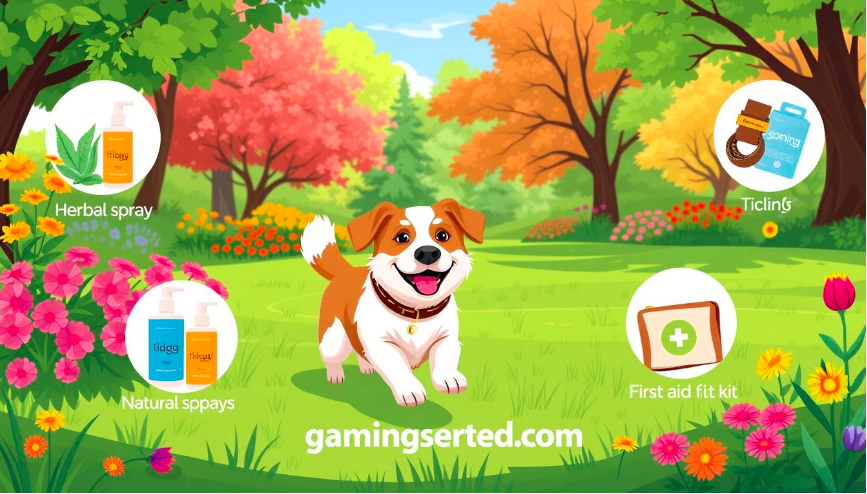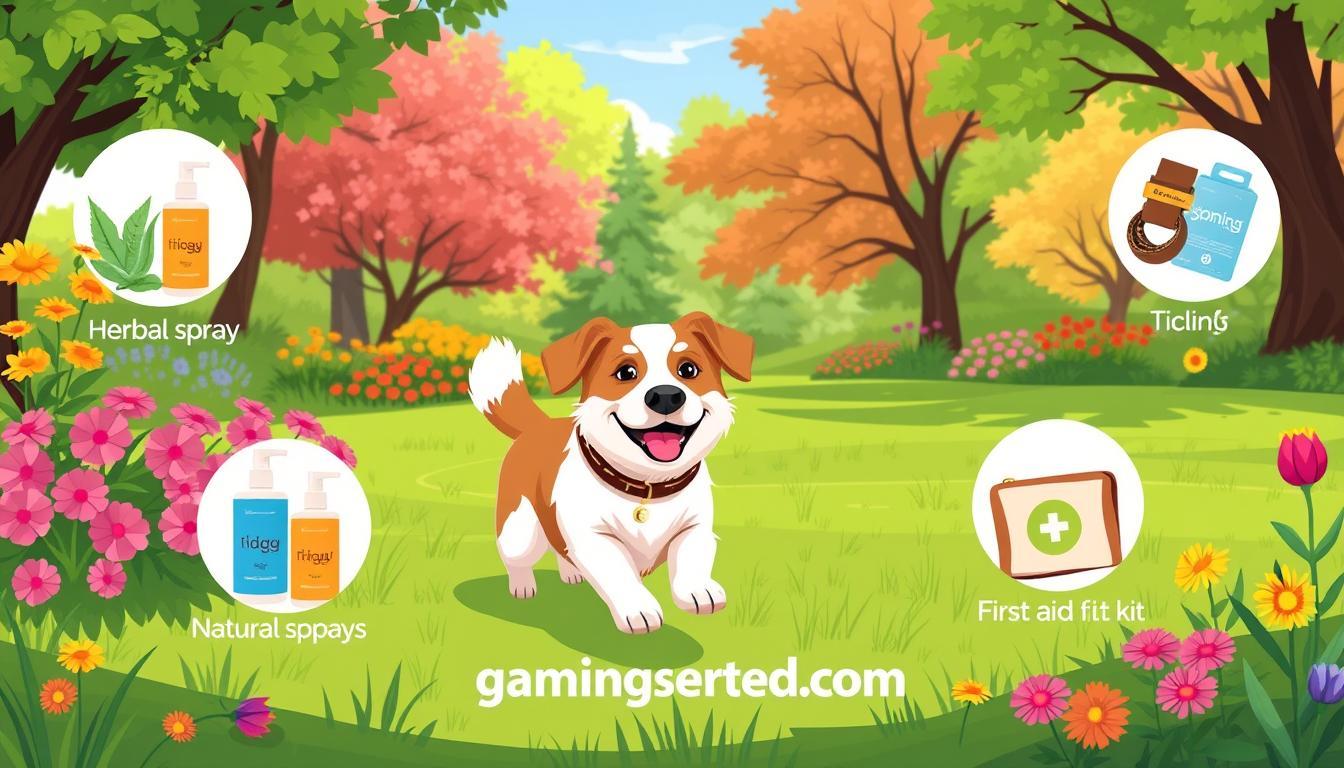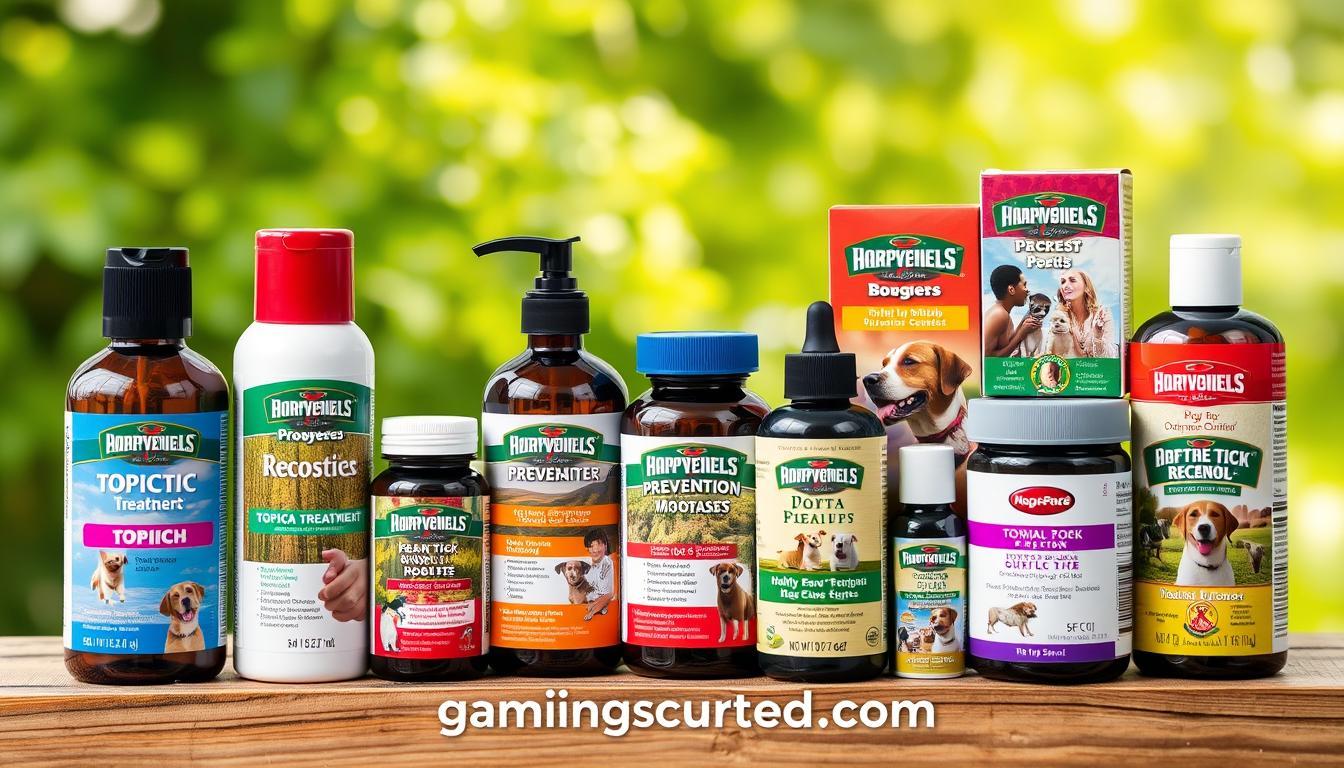Best Dog Tick Prevention: Ultimate Guide for Pet Safety

Discover the most effective ways to protect your furry friend with my comprehensive guide to best dog tick prevention. Keep your pet safe and healthy all year round.
Best Dog Tick Prevention: Ultimate Guide for Pet Safety
As a devoted dog parent, I know how vital it is to keep my furry friend safe and healthy. Preventative care is key, and monthly flea and tick preventatives are a must. Fleas and ticks are more than just pests; they feed on blood, causing health issues and spreading diseases like Lyme disease.
Prevention should begin as early as 8 weeks old and go all year round, no matter the season. Luckily, there are many products to protect my dog. From topical treatments like Frontline Plus to oral meds like Credelio, there's something for every dog's needs.

Key Takeaways
- Preventative care is essential for dog health, with monthly flea and tick preventatives being a must.
- Fleas and ticks can cause direct health issues and spread diseases like Lyme disease.
- Prevention should start at 8 weeks old and continue year-round, with a variety of product options available.
- Topical, oral, and collar-based products offer different levels of protection and convenience.
- Consistent application as per manufacturer instructions is key for the best protection.
Understanding the Threat: Why Tick Prevention Matters
Keeping our dogs safe from ticks is very important. Tick bites can cause serious health problems, like infections and even death. These pests spread diseases like Lyme disease and Rocky Mountain spotted fever, harming both pets and people.
Health Risks Associated with Tick Bites
Diseases from tick bites can be hard to spot, as symptoms may take weeks to show. This makes it even more important to prevent ticks. If not treated, these diseases can cause serious issues, including organ damage and death.
Common Diseases Transmitted by Ticks
- Lyme disease: A bacterial infection that can cause lameness, fever, and chronic joint pain in dogs.
- Rocky Mountain spotted fever: A potentially fatal illness characterized by fever, rash, and neurological symptoms.
- Ehrlichiosis: A tick-borne disease that can cause fever, lethargy, and bleeding disorders in canines.
Impact on Dog and Human Health
Ticks can also spread diseases to humans, making tick prevention key for everyone. Protecting our pets helps keep our whole family healthy. It's a way to look out for each other's well-being.
"Tick prevention is not just about keeping our dogs safe - it's about safeguarding the health and well-being of our entire family."
Best Dog Tick Prevention Methods and Products
Keeping your dog safe from ticks is key to their health. Luckily, there are many top tick preventatives for dogs and tick medicine for dogs to fight off these pests.
Popular tick prevention products include Advantage®, Bravecto®, Comfortis®, Credelio®, and Frontline®. They come in forms like topical solutions and chewable tablets. These products use ingredients like imidacloprid and fluralaner to kill fleas and ticks.
There are also natural tick preventatives for dogs like Natural Care's Advanced line. It uses plant-based ingredients like clove oil to repel and kill ticks.
| Product | Active Ingredient | Application | Protection Period |
|---|---|---|---|
| Advantage® | Imidacloprid | Topical | 30 days |
| Bravecto® | Fluralaner | Chewable | 12 weeks |
| Comfortis® | Spinosad | Chewable | 30 days |
| Credelio® | Lotilaner | Chewable | 30 days |
| Frontline® | Fipronil | Topical | 30 days |
Choosing the right tick preventatives for dogs depends on your dog's size, age, and health. Talking to your vet is important. They can help pick the best tick medicine for dogs for your pet.
Choosing the Right Tick Prevention Based on Dog Size and Age
Protecting your dog from tick-borne illnesses is very important. It's key to pick the right tick prevention based on your dog's size and age. Many flea treatments aren't safe for puppies under eight to 12 weeks. Always talk to your vet before using any tick prevention on your young dog.
Weight-Based Dosing Guidelines
Using the right amount of tick prevention is vital for safety and effectiveness. Flea collars like Seresto® can last up to eight months. Topical treatments like Advantage Multi® and Frontline® Plus need to be applied monthly. Oral meds like Simparica® and Trifexis offer longer protection, but always follow the dosage based on your dog's weight.
Age Restrictions for Different Products
Age matters when picking tick prevention for your dog. Most products are safe for puppies 6-8 weeks and older. Always check the label and talk to your vet to make sure the product is right for your dog's age.
Breed-Specific Considerations
Some dog breeds, like Collies and Australian Shepherds, may not be able to handle certain medications. Bravecto chews, for example, might not be good for these breeds. It's important to discuss any breed-specific concerns with your vet to keep your dog safe and healthy.
Keeping your dog safe from tick-borne illnesses is a top priority. Choosing the right tick prevention method is essential based on your dog's size, age, and breed. By working closely with your vet, you can ensure your dog is protected from these harmful parasites.
Oral vs. Topical Tick Preventatives: Pros and Cons
Protecting your dog from ticks can be done in two ways: oral or topical tick preventatives. Each has its own benefits, depending on your dog's life and what you prefer. Let's look at the good and bad of each to help you decide.
Oral Tick Preventatives
Oral tick medicine for dogs comes as chewable tablets or treats. They are easy to give to pets. These medicines work through the blood, protecting your dog's whole body and keeping ticks away.
Some oral preventatives also stop ticks from growing. They target young ticks and nymphs, helping to lower the tick population on your pet.
Topical Tick Preventatives
Topical tick spray for dogs lasts up to a month, so you don't have to apply it as often. You put it on your dog's skin and coat. It creates a barrier that repels and kills ticks.
Topical treatments might be better for dogs with sensitive stomachs or who don't like to eat certain things. They don't need to be swallowed.
When picking between oral and topical tick preventatives, think about your dog's life and what they like. Talk to your vet to find the best option for your pet's health.
"Proper tick prevention is key for our dogs' health. Knowing the good and bad of each option helps us choose the best for our pets."
The right choice between oral and topical tick preventatives depends on your dog's needs and what they like. By considering the benefits and drawbacks of each, you can pick the best protection for your dog against ticks.
Natural Tick Repellent Options for Dogs
As a pet parent, I know how vital it is to shield my furry friend from tick-borne diseases. Many pet owners opt for natural tick repellents over chemical ones. These natural options are kinder to your dog's health and the planet. There are many effective natural tick repellents to keep your pup safe.
Essential Oils and Their Effectiveness
Essential oils like clove, lemongrass, peppermint, and cedarwood repel ticks naturally. Clove oil, for example, contains eugenol, which repels and kills ticks. Peppermint and cedarwood oils also create a barrier against ticks, studies show.
Herbal Solutions for Tick Prevention
Some herbs and natural ingredients help keep ticks away. Garlic in a dog's diet makes their blood less appealing to ticks. Apple cider vinegar, used topically or in water, also deters ticks.
DIY Natural Repellent Recipes
You can make your own tick repellent at home. Mix essential oils like clove and lemongrass with a carrier oil like almond or coconut oil. Always check with your vet before using homemade repellents to make sure they're safe for your dog.
While natural repellents work well, keep a close eye on your dog. Talk to your vet to ensure your dog's safety and health. By trying these natural options, you can protect your furry friend from tick-borne diseases.
Year-Round vs. Seasonal Tick Prevention Strategies
Protecting our dogs from ticks is a big deal. The debate between year-round and seasonal prevention is key. Year-round prevention is best because fleas and ticks can live indoors, even in winter.
Seasonal tick control might seem good in some places. But, changing weather and tick habits make it not enough. Places with milder winters, like the West Coast and southern states, need constant protection.
Even in colder areas, climate change is changing things. Central and northern states are seeing more fleas and ticks. These pests can survive very low temperatures.
| Advantage | Year-Round Tick Prevention | Seasonal Tick Prevention |
|---|---|---|
| Continuous Protection | ✓ | X |
| Effectiveness | ✓ | X |
| Versatility Across Climates | ✓ | X |
Studies show year-round tick prevention for dogs is key. Ticks can spread diseases like Rocky Mountain spotted fever and Lyme disease. Keeping dogs on a good best dog tick prevention plan all year lowers disease risk, even if it's not 100%.
In short, experts and science back year-round tick prevention for dogs. It keeps them safe and healthy all year.
How to Apply Different Types of Tick Preventatives
It's important to apply tick prevention products correctly for your dog's safety. Whether you use a topical treatment or an oral medication, the right application is key. This helps protect your dog from ticks and the diseases they carry.
Proper Application Techniques
- For topical treatments, apply the product between your dog's shoulder blades or down their back. Make sure the liquid reaches the skin.
- Oral medications should be given as directed, often with food. This ensures proper absorption and effectiveness.
- Part your dog's fur to allow the product to penetrate directly onto the skin. This is better than just coating the hair.
Safety Precautions During Application
When applying tick prevention products, safety is a must for both you and your dog:
- Keep children and other pets away from the treated area until it's fully dried.
- Avoid direct contact with the product. Some ingredients can irritate human skin.
- Wash your hands thoroughly after applying the tick spray for dogs or tick medicine for dogs.
Post-Application Care
After applying a tick preventative, watch your dog for any signs of trouble. Look for skin irritation or excessive licking. If you see any concerning symptoms, call your vet right away. Also, keep checking your dog for ticks, even with prevention products, to keep them safe.
"Proper application and vigilance are key to effectively protecting your dog from ticks and the diseases they can transmit."
By following these best practices for applyingtick spray for dogsandtick medicine for dogs, you can keep your dog safe and healthy all year.
Signs of Tick Infestation and What to Do
As a responsible pet owner, it's important to watch for tick signs on your dog. Ticks can harm your dog's health by spreading diseases like Lyme disease and Rocky Mountain spotted fever. By being alert and acting fast, you can protect your dog from these dangers.
Look for ticks on your dog's body, like in the ears, eyelids, and under the collar. If you find any, remove them quickly and correctly to stop disease spread.
Your dog might scratch a lot, have small bumps, or seem tired if they have ticks. Seeing these signs means you should see your vet right away. They can tell you what to do next, like using tick prevention for dogs.
Keeping your dog safe from ticks is key. This might mean using topical treatments, oral preventatives, or both. Your vet can help pick the best option for your dog.
Regular vet visits and watching for tick signs are important. By being proactive, you can enjoy safe outdoor time with your dog.
| Symptom | Significance |
|---|---|
| Visible ticks on the body | Indicates an active infestation and possible disease spread |
| Excessive scratching or licking | May be a tick bite or skin irritation response |
| Small bumps on the skin | Can show tick attachment or skin irritation |
| Lethargy or reduced activity | May be a sign of a tick-borne illness |
If you think your dog has ticks or shows odd symptoms, see your vet right away. They can help keep your dog healthy and safe.
Environmental Control: Protecting Your Yard from Ticks
Keeping your yard tick-free is key for your dog's safety. As warmer months come, it's vital to make your yard less welcoming to ticks. Use smart landscape tips and natural treatments to lower the risk of tick bites for your dog.
Landscape Management Tips
- Keep your grass short and well-trimmed. Ticks prefer tall, overgrown areas, so regular mowing helps keep them away.
- Remove leaf litter and debris from your yard. Ticks hide in these spots, so a clean yard is essential.
- Create a barrier between your lawn and wooded areas or dense plants. Use gravel or wood chips to block ticks' habitats.
Natural Yard Treatments
For a natural tick prevention, try these eco-friendly options:
- Cedar Oil: This oil repels ticks well. Use it in areas where ticks are common.
- Diatomaceous Earth: This powder can be used in busy spots to dehydrate and disrupt ticks, making your yard less appealing to them.
Combining yard care with natural treatments can greatly reduce ticks in your yard. This makes a safer space for your dog to play. Always be watchful and protect your dog from tick-borne diseases.

Prescription vs. Over-the-Counter Tick Prevention Products
Protecting our dogs from ticks is a big concern for pet owners. We face a choice between prescription and over-the-counter (OTC) tick preventatives. Knowing the differences helps us choose wisely.
Prescription tick medicines, like Bravecto and Credelio, offer strong protection. They fight a wide range of parasites, including ticks, fleas, and heartworms. Vets pick the best option for your dog, ensuring safety and effectiveness.
OTC tick medicine for dogs is easy to find but might not be as good. They can be less strong and riskier for your dog. Some ticks also resist these products, making them less effective.
Regulations play a big role. Prescription top tick preventatives for dogs face strict FDA rules. OTC products, though, are overseen by the EPA with less strict rules.
Choosing between prescription and OTC tick prevention should be a vet's call. They know your dog's needs and health concerns. They'll pick the best option to keep your dog safe from ticks.
"Choosing the right tick prevention product for your dog is a critical decision that can have lasting impacts on their health and well-being. Consult with your veterinarian to ensure you make the best choice."
Common Mistakes in Dog Tick Prevention to Avoid
Keeping our dogs safe from ticks is very important. But, it's easy to make mistakes in tick prevention. We'll look at common errors to avoid for your pet's health.
Dosing Errors to Watch For
Getting the right amount of tick prevention is key. Too little might not protect your dog, while too much can harm them. Always follow the product's weight-based instructions and consult your veterinarian if you have any doubts. Never use dog-specific products on cats, as this can be fatal.
Timing and Application Mistakes
Being consistent with tick prevention is important. Skipping applications, even in cold months, can put your dog at risk. Also, bathing your dog right after applying a treatment can make it less effective. Be diligent about keeping up with the recommended application schedule and timing, and avoid washing your pet for at least 24-48 hours after application.
Staying alert and avoiding these mistakes is vital for your dog's safety. By following instructions and talking to your vet, you can keep your pet healthy and safe.
| Mistake | Consequence | Prevention Tip |
|---|---|---|
| Using expired products | Reduced effectiveness | Check expiration dates and replace as needed |
| Incorrect dosing based on weight | Potential overdose or underdose | Follow product instructions carefully |
| Inconsistent application | Gaps in protection | Maintain a consistent schedule |
| Bathing after topical treatment | Reduced efficacy | Avoid bathing for 24-48 hours after application |
| Using dog products on cats | Potential toxicity | Never use dog-specific products on cats |
"Proper tick prevention is essential for the health and well-being of our canine companions. By being diligent and avoiding common mistakes, we can help keep our furry friends safe from the dangers of tick-borne illnesses."
Cost Comparison of Different Prevention Methods
There are many top tick preventatives for dogs to pick from. The prices of these tick medicine for dogs vary a lot. But, it's key to think about how much each one will cost over time.
Prescription tick medicine for dogs might cost more at first. But, they often protect better. Natural options like essential oils and herbs are cheaper. Yet, they might need more use to work well.
Some tick preventatives for dogs last for months, which can save money. For instance, Bravecto and NexGard protect against fleas and ticks for up to 12 weeks. That's almost 3 times longer than some other brands.
When looking at the cost of tick medicine for dogs, think about vet bills for tick diseases. Good tick preventatives for dogs can save you money on vet visits later.
| Product | Protection Duration | Approximate Yearly Cost |
|---|---|---|
| Bravecto | 12 weeks | $150 - $200 |
| NexGard | 1 month | $120 - $180 |
| Simparica Trio | 1 month | $180 - $240 |
The best tick medicine for dogs is one that protects well, is simple to use, and is affordable. Talk to your vet to find the best tick preventatives for dogs for your pet.

Special Considerations for Multi-Pet Households
As a pet owner with multiple furry friends, it's key to protect them all from ticks. Treating all pets for ticks is vital to stop them from spreading ticks to each other. When it comes to tick prevention for dogs, use products made just for dogs. Dog tick preventatives can harm other pets like cats.
It's wise to use the same natural tick repellent for dogs for all pets, if it's safe for each one. This makes treatment easier and helps fight ticks by treating the whole house.
But, treating pets isn't enough. You also need to tackle the environment. Use landscape management and natural yard treatments to get rid of tick spots and lower the risk of ticks.
Also, watch out for product transfer between pets right after treatment. Some preventatives can move from one pet to another. So, keep pets apart for a bit after treatment to make sure each one gets the right amount safely.
| Key Considerations for Multi-Pet Households | Description |
|---|---|
| Treat all pets | Ensure all animals in the household are treated with appropriate tick prevention methods to avoid cross-infestation. |
| Use species-specific products | Utilize tick preventatives designed for each pet's species, as dog products can harm cats. |
| Standardize prevention methods | Consider using the same brand of tick prevention across all pets for a consistent approach and to break the tick life cycle. |
| Treat the environment | Address the environment by implementing landscape management and natural yard treatments to eliminate tick habitats. |
| Monitor for product transfer | Be cautious of possible product transfer between pets right after application, as it can affect dosage and safety. |
By considering these special points, you can keep all pets safe from ticks. This ensures a tick-free home and keeps your furry family members healthy.
Conclusion
Keeping your dog safe from ticks is key to their health. As a pet owner, picking the right prevention method is important. It should match your dog's lifestyle and you should check with your vet often.
Regular use of tick preventatives is essential. So is keeping your environment clean and checking your dog often. This way, you can protect them fully.
It's vital to know about new tick prevention products and local tick populations. Many dog owners in the US, UK, and Australia use Bravecto. It's long-lasting and works well.
Using these methods together helps keep your dog safe and healthy. It also lowers the risk of tick-borne illnesses for you and your family.
Preventing ticks is a continuous task. But being proactive and careful lets your dog enjoy the outdoors safely. With the right steps, you can protect your dog from ticks and keep them healthy.
FAQ
What are the health risks associated with tick bites for dogs?
Tick bites can cause serious health problems in dogs. These include infections, abscesses, paralysis, and even death. Diseases like Lyme disease and Rocky Mountain spotted fever can spread from dogs to humans. This makes it vital to prevent ticks for both pets and people.
What are the most effective tick prevention products for dogs?
Top tick prevention products for dogs include Advantage, Bravecto, Comfortis, Credelio, and Frontline. They contain ingredients like imidacloprid and fipronil that kill fleas and ticks. Some also protect against heartworms and intestinal worms.
What factors should I consider when choosing a tick preventative for my dog?
When picking a tick preventative, think about your dog's size, age, and breed. Also, consider their lifestyle and preferences. Oral preventatives are easy to use, while topical treatments might be better for dogs that need regular baths. Certain breeds, like Collies, may react differently to medications, so always check with your vet.
What are some natural tick repellent options for dogs?
Natural tick repellents include essential oils like clove oil. DIY repellents can be made with these oils. But, always talk to a vet before using homemade solutions to ensure they're safe and work well.
Is year-round tick prevention necessary, or can I use a seasonal strategy?
It's best to use tick prevention all year, as fleas can live indoors even in winter. Seasonal strategies might not be enough, mainly in mild climates. Keeping up with preventatives all year keeps your dog safe from ticks and diseases.
How do I properly apply tick preventatives to my dog?
For topical treatments, apply between the shoulder blades or down the back. Oral treatments should be given with food, as directed. Always follow safety tips, like keeping kids and pets away until it's dry, and watch for any bad reactions.
What are the signs of a tick infestation on my dog?
Signs include visible ticks, excessive scratching, and small bumps on the skin. Regularly check your dog, focusing on ears, eyelids, under the collar, and around the tail.
How can I reduce tick populations in my yard?
Keep your grass short, remove leaf litter, and create barriers. Use natural treatments like cedar oil or diatomaceous earth. Regular yard maintenance, like mowing and raking, also helps reduce ticks.
What are the differences between prescription and over-the-counter (OTC) tick prevention products?
Prescription tick preventatives are safer and more effective, needing a vet's approval. Products like Bravecto offer broad protection against parasites. OTC options might not protect as well.
What are some common mistakes to avoid when using tick preventatives for dogs?
Avoid expired products, wrong dosing, and skipping applications. Never use dog products on cats, as it can be deadly. Always read labels carefully and follow your vet's advice.
- Pet
- Discover the Majestic World of Horses: Care & Training
- Technology
- Business
- Health
- Art
- Causes
- Crafts
- Dance
- Drinks
- Film
- Fitness
- Food
- Games
- Gardening
- Health
- Home
- Literature
- Music
- Networking
- Other
- Party
- Religion
- Shopping
- Sports
- Theater
- Wellness



